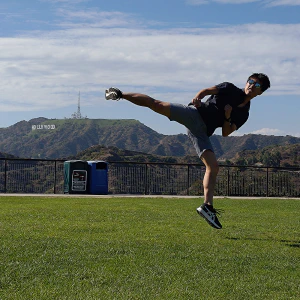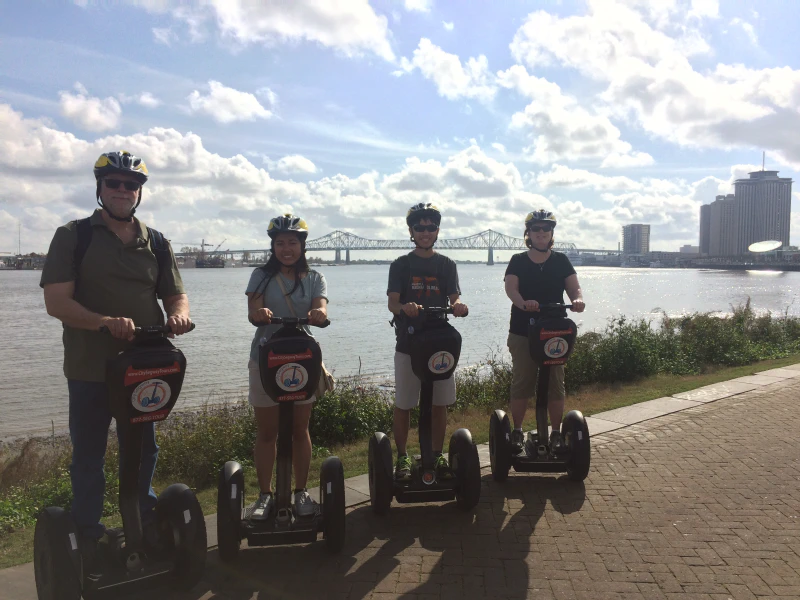Posted
on
in
Caribbean Cruise 2016-17
• 1101 words
• 6 minute read
Tags:
Battle of New Orleans, Louisiana, New Orleans
Today we went on a Segway tour of the city and then went straight to a river boat tour which went down the Mississippi River to the site of Andrew Jacksons stand in the Battle of New Orleans.
Segway Tour
After breakfast, we walked to Decatur street where the Segway tour company is located. We practised riding the Segways in the company’s “office” and then headed out onto the streets.
We toured all around the French Quarter and into two of the surrounding neighbourhoods. The guide explained some of New Orleans’ history and pointed out some of the interesting sights along the way. One of the most interesting thing was that New Orleanians don’t call medians “medians”, they call them “neutral grounds”. This is because each of the neighbourhoods used to be separately governed. The streets, however, were neutral and thus all commerce was done in the middle of the street out of reach of either jurisdiction. So to this day, medians in New Orleans are called “neutral grounds”.
Our guide also explained some of the History of New Orleans. I’ve compiled what I’ve learned from our various guides below. (If there are any inaccuracies, please let me know.)
History of New Orleans
The Mississippi River and all of its watershed were claimed for France by in 1699. New Orleans was founded by the French in 1718. The French controlled New Orleans for about 50 years. The French built New Orleans in the area that is now known as the French Quarter, but only three buildings in that neighbourhood are actually French. The others were burned in the fires during the Spanish rule.
New Orleans came under Spanish rule after the Seven Years War. Known in the American Theatre as The French and Indian War, the Seven Years War was the first worldwide war. The end result that we care about is that France ceded all of Louisiana to Spain in the treaty ending the war. New Orleans was not notified of the change in rule for two years. During Spanish rule, the city burned to the ground twice. The first time because someone didn’t extinguish his altar candles while he went to lunch. After that fire, the city was rebuilt in the Spanish style and as they were rebuilding, a second fire broke out, this time due to two boys playing with matches in a hay shed. After this second devastating fire, the Spanish rebuilt again, this time implementing fire codes preventing houses from being made of wood and requiring courtyards with wells to be able to fight fires.
In 1800, Napoleon corrected the Spanish to give Louisiana back to the French. Three years later, in 1803, Thomas Jefferson bought Louisiana in the biggest land deal in the history of the world. Jefferson only wanted to buy New Orleans for 10 million dollars. Napoleon was in need of money to conquer Europe, so he offered to sell all of Louisiana for 15 million dollars. Thomas Jefferson agreed and so the biggest land deal in history was made. The land acquired ended up costing 4¢/acre. Where did the extra 5 million dollars come from? Britain loaned it to us. What did Napoleon do with the money? He attacked Britain.
New Orleans has always been a strategic strongpoint on the Mississippi since whoever controls that city controls all commerce along the Mississippi. The British knew this, and during the War of 1812, the British attacked New Orleans. Until this point in the war, American forces had invaded French Canada conquering Montreal but then being defeated on the Plains of Abraham outside of Quebec (see my post from this summer when my mom and I were there). Over in Europe, Napoleon was defeated (remember, Napoleon was fighting the British with American money borrowed from the British) and the entire might of the British Empire came to bear on the small United States of America. Washington DC was sacked, the Capital and White House was burned, and George Washington’s portrait was saved by the First Lady. The British advances in the north were halted at Ft. McHenry where the famous words of the national anthem were penned by Francis Scott Key.
The British then moved south and invaded New Orleans. After gaining control of Lake Borgne, the British landed and camped at a plantation south of New Orleans in late December. Upon hearing this, Andrew Jackson, the general in charge of protecting the city of New Orleans, ordered a night attack of the British encampment. The British held their position, but preparations were delayed giving the Americans time to fortify a canal on the Chalmette Plantation. The spot was specifically chosen because it was the narrowest point between the British and New Orleans. On January 8th, the British attacked. The British had to advance across wide open fields to attack the American position. They marched in the traditional head-on attack formation but despite their ranks being torn apart by cannon, musket and rifle fire from behind the battle work, the British soldiers continued marching. Jackson later said after the battle that he respected the soldiers for their relentless marching in the face of enormous casualties. The British commander and many officers were killed, and the Americans grapeshot ripped through the British lines. Few British made it to the breastwork and those that scaled it were immediately killed or captured. After suffering huge losses, the British commander in reserve brought his troops to cover the retreat of what remained of the British army on the field. Casualties for the British totalled over 2000 (285 of which were killed). There were 62 casualties (13 killed) for the Americans. Jackson did all of this with only 4500 men while the British had nearly 14,000.
Because of the significance of the Battle of New Orleans, January 8th was celebrated as the second Independence Day in America. During the Civil War, however, Louisiana became part of the Confederate States of America and the importance of the Battle of New Orleans was greatly marginalized during the Reconstruction period.
Boat Tour
After the Segway tour we went on a riverboat tour where we went down the river to the Chalmette Plantation, the site of the Battle of New Orleans. As I have already described the battle, I won’t elaborate here. On the way down, we saw the Lower and Upper Ninth Ward and St. Bernard Parish where the majority of the flooding occurred during Hurricane Katrina and our guide described some of the various sights along the way.
I’ll go ahead and stop here, I am already behind on my writing.

